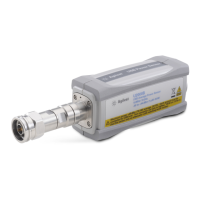
Do you have a question about the Agilent Technologies U2000 Series and is the answer not in the manual?
| Brand | Agilent Technologies |
|---|---|
| Model | U2000 Series |
| Category | Accessories |
| Language | English |
Information regarding the material warranty and disclaimers.
Details on hardware and software licensing terms.
Information on government rights for software and technical data.
Explanation of WARNING and CAUTION notices for hazards.
Critical safety warning about connecting instruments to protective ground.
Safety cautions for using the device and performing repairs.
Compliance note for safety and EMC requirements.
Overview of Agilent U2000 Series USB power sensors and their applications.
Detailed description of the physical parts and connectors of the power sensor.
Explanation of the LED indicator states and their meanings.
Explanation of how the U2000 Series USB power sensors function.
In-depth look at the technology and design of the USB power sensors.
Instructions for checking the shipping container and product for damage.
List of items included in the standard purchase of the USB power sensors.
Guidance on installing and configuring the power sensor hardware.
Minimum requirements for PC and software for sensor operation.
Step-by-step guide for installing the USB power sensor drivers.
Procedure to confirm the correct connection and installation of the power sensor.
Instructions for setting up the power sensor using Agilent Power Analysis Manager.
Methods to check the firmware revision of the connected power sensor.
Description of the two measurement modes: Average only and Normal.
Explanation of how the measurement gate is used to extract trace data.
Details on automatic and manual configuration settings for the power sensor.
Information on how measurement accuracy and speed are affected by settings.
Manual and automatic options for setting the sensor's measurement range.
Factors influencing measurement accuracy like crest factor and duty cycle.
How averaging settings affect measurement speed and noise.
Procedures for performing internal and external zeroing for accuracy.
Features for automating frequency and power sweep operations.
Using step detection to optimize filter settling time after power changes.
Performing average power measurements on pulsed signals.
Overview of specifications and characteristics for the USB power sensors.
Defines warranted vs. characteristic specifications and their types.
Specifications covered by product warranty and including measurement uncertainty.
Typical performance parameters not covered by warranty.
Key technical specifications of the power sensors.
Defines the operational frequency and power ranges for each sensor model.
Details on the connector types and impedance used by the sensors.
Maximum Standing Wave Ratio specifications at a specific temperature range.
Graphical representation of SWR versus frequency for various models.
Maximum Standing Wave Ratio specifications across the operating temperature range.
Specifies the maximum power handling capabilities of the sensors.
Details on the power measurement accuracy under different conditions.
Overall characteristics including physical, storage, and USB specifications.
Information on the physical dimensions and net weight of the sensors.
Recommended environmental conditions for storage and shipment.
Details on the USB speed supported by the sensors.
Typical Calibration Factor uncertainties for various frequency ranges.
Specifications related to internal and external trigger inputs.
Key performance parameters specific to Normal mode operation.
Overview of maintenance, troubleshooting, and repair procedures.
Instructions for cleaning the body of the USB power sensors.
Guidelines for safely cleaning the RF connector.
Procedures and considerations for testing sensor performance.
Detailed test procedures for SWR and Reflection Coefficient.
List of available replaceable parts and ordering information.
General service information including troubleshooting and repairs.
Guidance on diagnosing and resolving common issues with the sensors.
Procedure for returning a defective sensor for module replacement.
Step-by-step instructions for disassembling the power sensor.
Procedure for safely disassembling the power sensor housing.
Instructions for reassembling the power sensor after repair.
Specific disassembly and reassembly for attenuators on U2000B/U2001B.
Procedure for disassembling the attenuator connector.
Detailed specifications for zero set, drift, and noise for specific sensor models.